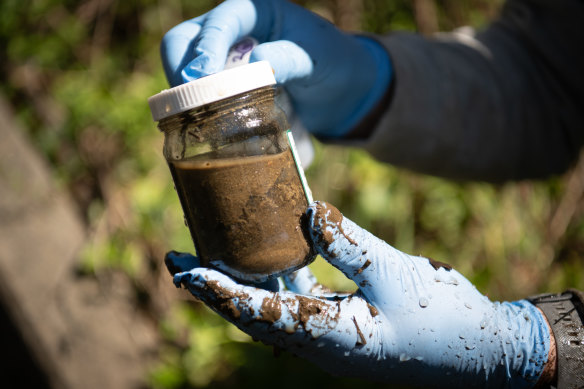By Ben Cubby and Carrie Fellner
Authorities are considering a long-term shutdown of Medlow Dam in the Blue Mountains, as independent tests show high levels of cancer-linked PFAS chemicals are embedded in the sediment in nearby waterways.
WaterNSW said it may upgrade drinking water filtration infrastructure, or try and isolate the source of contamination away from the dam network.

Western Sydney University water scientist Ian Wright takes a sample in Adams Creek, which feeds Medlow Dam.Credit: Wolter Peeters
Extra water may be pumped in from Oberon Dam to supply the drinking water to Blue Mountains residents after Medlow Dam and neighbouring Greaves Creek Dam were closed off from the drinking water system on August 28.
A WaterNSW source said there is “no obvious solution” to the problem, and investigations into the origin of the PFAS pollution may take weeks.
Independent tests commissioned by the Herald earlier this month showed PFAS levels in a creek that flows into Medlow Dam at 50 times the Australian drinking water guidelines – far higher than authorities have previously admitted.
Blue Mountains residents are concerned that they may have been drinking PFAS-contaminated water for decades. NSW Health said in a statement that drinking water is safe.

A sediment sample from a waterway near Medlow Dam.Credit: Wolter Peeters
Sediment tests commissioned by the Herald show the chemical signature of PFAS products that have not been widely used for two decades, suggesting that contamination has been going on for a long time.
But the problem was only uncovered in June following a Herald investigation revealed that no large-scale testing for PFAS in the state’s drinking water was taking place. The official position was that routine monitoring of tap water was unnecessary because there were “no known PFAS hotspots in the catchment”.
Former NSW Australian of the Year Jon Dee, who lives near the contaminated area, said residents were deeply concerned and wanted the Cascade water filtration plant, which supplies drinking water to 49,500 people, upgraded.
“At the moment, people in the Blue Mountains are being forced to drink tap water that’s considered unsafe in America,” Dee said.
Dee is working with the NSW Environmental Defenders Office, which will write to Sydney Water, WaterNSW and the NSW Environment Protection Authority on Wednesday calling for improved water filtration.
Dee is also seeking “an investigation to determine if there are above normal levels of PFAS-linked cancers and other PFAS-linked health impacts in the population of the Blue Mountains.”
“It beggars belief that the public is having to rely on the Sydney Morning Herald to monitor the cleanliness of our tap water and waterways,” he said.
Asked whether Blue Mountains residents could have been exposed to PFAS through tap water for years without knowing, NSW Health simply said that recent tests showed it was within safe levels.
“NSW Health has assured the community that Sydney drinking water is safe to drink,” a NSW Health spokesperson said.
“Sydney Water Corporation’s recent monitoring of treated drinking water in Sydney, including from the Cascade Water Filtration Plant, found no detections above the health-based guideline values in the Australian drinking water guidelines.”
Western Sydney University water scientist Ian Wright said the presence of high levels of PFOS, or perfluorooctanesulfonic acid, in sediment at Adams Creek suggested contaminants had been flowing through the drinking water supply for decades.
PFOS, which is stain, grease, soil and water resistant, was used in some firefighting foams but production ceased in 2001 and the foams were not in use after 2007.
“Looking at the PFOS levels in the samples, given that it was banned 15 years ago, it tells us that this is something that’s been happening over decades,” Wright said. “That’s rocked me a bit.”
“Sediment is a long-term record of what’s been going past. It grabs PFAS that flows over it in the water and holds onto it. So you can get a sense of the history by looking at the sediment.
“This may have been going for a long time. People in the area were drinking the tap water through that time, and we don’t know what it contained before they started sampling in June.
PFOS was found at a level of 32 micrograms per kilogram in sediment at Adams Creek, Wright’s tests found.
PFOS is part of the PFAS group of chemicals, some of which have been linked with causing cancer and other health problems.
WaterNSW said its investigation into the source of the pollution was ongoing.
“The extensive WaterNSW sampling program is occurring alongside work with multiple agencies to explore historical land use activities such as firefighting, which may have involved PFAS,” the agency said in a statement.
“The outcome of the investigation will inform the next steps to further mitigate the risk, for example isolating water run-off from contaminated areas of the catchment, and/or modifying infrastructure at the extraction and treatment point,” it said.
“The Sydney Water Cascades Water Filtration Plant is being supplied by the Cascades catchment and can be supplemented by the Fish River water supply scheme in the Oberon catchment, which had close to zero detections of PFAS in the raw water – if needed.”
The Blue Mountains City Council has not yet received a briefing on the situation from the state government. The Herald understands that returning mayor Mark Greenhill will seek an urgent briefing from the government when he is sworn in.
The NSW Greens on Tuesday called for an Upper House inquiry into PFAS pollution in the Sydney Water Catchment.
“It shouldn’t have to take media exposure before the government acts, yet that’s exactly what’s happening,” said Greens MP Cate Faehrmann.
Get to the heart of what’s happening with climate change and the environment. Sign up for our fortnightly Environment newsletter.